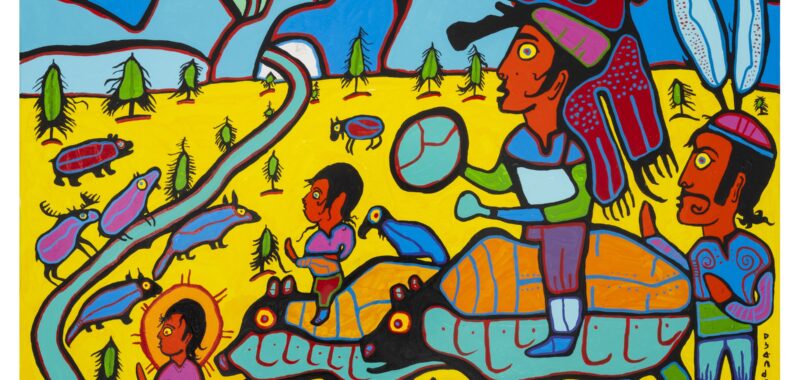In an update to one of the largest art fraud cases in Canada, David John Voss of Ontario received a five-year sentence after pleading guilty in June for his role in an art fraud ring that forged and sold thousands of paintings falsely attributed to late Anishinaabe artist Norval Morrisseau. Voss’s sentencing follows that of co-conspirator and convicted sexual assailant Gary Lamont, who was handed a five-year sentence last December for his involvement in the fraud ring.
According to the case, Voss reportedly developed and oversaw an assembly line-style production process, having recruited artists to work with “paint by numbers” outlines he had drawn to imitate Morrisseau’s colorful style and spiritually imbued subject matter. The ring operated in Ontario from the mid-’90s to 2019, disseminating thousands of counterfeit paintings into the hands of dealers and buyers alike. Eight people were arrested and charged in connection to the ring in 2023, including Voss, Lamont, and the late artist’s own nephew, Benjamin Morrisseau.
Hyperallergic was unable to get in contact with Voss or his legal representation for comment.

Norval Morrisseau, who also went by the name Copper Thunderbird, was born in 1932 to the Bingwi Neyaashi Anishinaabek First Nation on the Ojibwe Reserve near Beardsmore, Ontario. The artist was raised in the Anishinaabe culture until the age of six, when he was sent to a Catholic residential school, enduring abuse for four years before being able to reconnect with his culture and traditions. A self-taught artist, Morrisseau was credited with developing the Woodlands School of Canadian Art — a style that visually transcribed Ojibwe oral histories and cosmology through petroglyph-inspired renderings of people and animals in bright colors with bold patterns and outlines. He remained active from the 1960s until his death from complications due to Parkinson’s Disease in 2007. With dozens of solo exhibitions across Canada and the United States, he has been popularly regarded as both the “grandfather of contemporary Indigenous art.”
“Norval Morrisseau is one of the world’s greatest Indigenous artists — he’s the spiritual and cultural icon of Canada,” the artist’s estate director Cory Dingle said in an interview with Hyperallergic. “He enabled Canada to have a conversation on the world stage about systemic racism, the treatment of Indigenous people, and sexual freedom as a bisexual man out in the ’60s. Canada is ahead in many moral and ethical standpoints because of Morrisseau, his art, and his strength.”

Morrisseau himself was keenly aware of art forgers targeting his practice and worked to protect his legacy in the years leading up to his death through the creation of the Norval Morrisseau Heritage Society. However, Barenaked Ladies musician Kevin Hearn drew widespread attention when he sued Toronto’s Maslak-McLeod Gallery in 2013 after learning that he had purchased a fake Morrisseau painting from them in 2005. The lawsuit and investigation into the counterfeit artwork opened the floodgates for the discovery of the Ontario-based fraud ring.
Since 2019, thousands of counterfeit paintings have been reported and seized in connection with the investigation, sparking disappointment and ire among collectors who have shelled out between five and six figures for what they believed were authentic Morrisseau paintings. That’s not including the depreciation of actual paintings held by Morrisseau’s estate, which, as presiding Ontario Superior Court Judge Bonnie Warkentin told the CBC, has “irrevocably damaged” the artist’s legacy.
Voss identified around 1,800 fraudulent paintings throughout the litigation process. Dingle projects that the forgery ring was able to disseminate around 5,000 fakes into the art market in the last 30 years, noting that the estate currently has over 1,500 authentication requests in its queue.

Dingle told Hyperallergic that the fraud scheme has likely generated some $100 million in losses for Morrisseau’s estate and surviving descendants, not to mention the devastating commoditization of Anishinaabe traditions and culture. The courts declined to pursue restitution in this case due to the complex web of impacted parties — a decision that Dingle says he prefers, as it extended Voss’s sentence.
Left with cleaning up the market after what Dingle called the “largest cultural appropriation event in history,” he and the other volunteers with Morrisseau’s estate have trademarked the artist’s signature, collaborated with computer scientists on an AI model that can identify counterfeit paintings, and begun advancing policy change with pro bono assistance from law firms including Michon de Reya, Bereskin and Parr, and Clark Miller to protect not only Morrisseau’s legacy but that of any artist in North America in the future.
“It’s long overdue,” Dingle concluded. “It’s just not the artist and the estate. It’s the culture. It’s the whole art market. It’s all artists getting suffering from this. It’s also our inability to share our culture and heritage and moral lessons.”

